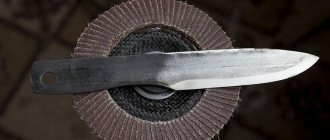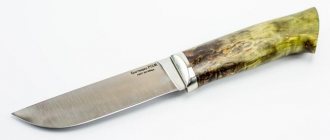Characteristics of steel grade 08Х18Н10Т
| Standard | GOST 5949-75 - Graded and calibrated steel, corrosion-resistant, heat-resistant and heat-resistant. Specifications | |
| Application | Welded equipment operating in highly aggressive environments, heat exchangers, muffles, pipes, furnace fittings, electrodes of spark plugs; austenitic steel | |
Steel 08Х18Н10Т
belongs to the class of alloyed, corrosion-resistant, heat-resistant steels of the austenitic group.
Supplied in the form of long products and sheets, calibrated rods and forged blanks.
The main areas of application of steel 08Х18Н10Т
08Х18Н10Т
used for the manufacture of welded units and devices, the operation of which takes place in highly aggressive conditions; heat exchangers and muffles; pipeline products, furnace fittings, spark plug electrodes.
Steel marking 08Х18Н10Т
Explanation:
“
08
” indicates a carbon content of up to 0.08%, “
X18
” is the indicator of the introduction of chromium into the alloy in the amount of 18%, “
H10
” - determines the nickel content of up to 10%, the letter “
T
” at the end of the marking is the titanium content in the amount up to 1.0%.
Decoding 08Х18Н10Т
fully reveals the main indicators of steel.
Types of stainless steel and its classification
The entire variety of anti-corrosion steel types is divided into 5 large groups. The basis for this division is the microstructure of the material. Of these, representatives of the following 3 groups are most often found:
- Martensitic steel is distinguished by the letter “C” in the marking. It acquires its properties not only due to its composition, but also as a result of hardening and tempering. Applicable in the production of cutlery and cutting tools. Slightly magnetized, has increased hardness.
- Ferritic alloy is softer than martensitic alloy. Also endowed with magnetic properties. Its designation contains the letter “F”.
- Austenitic steel, containing 15-20% Cr and 5-15% Ni, is not magnetized and has the highest resistance to corrosion. Denoted by the letter "A". Steel grades from this group are most common in industrial production, as well as in the manufacture of hardware and fastening devices.
In turn, austenitic alloys are divided into 5 classes, additionally indicated by a digital value:
- A1 is the least resistant to corrosion due to the sulfur contained in the chemical composition. Used for the manufacture of parts for mechanical and moving units.
- A2 is steel that is resistant to moisture, but is not suitable for work in environments containing acids, alkalis, chlorine and salts. Ecologically harmless, not magnetized, not subject to hardening. Excellent for the manufacture of all types of fasteners intended for use in non-aggressive conditions.
- A3 - similar in properties to class A2 steel. However, this metal better resists corrosion in high-temperature environments, due to the stabilization of the alloy with niobium, titanium or tantalum.
- A4 - differs from A2 steel in the presence of molybdenum in an amount of 2-3%. This small additive gives the metal high resistance to acids, alkalis, and salts. Can operate in low temperatures, down to -60°C. A4 fasteners are intended for the construction of bridges and coastal structures. It is used in shipbuilding, chemical and oil and gas enterprises.
- A5 is steel stabilized with titanium, which makes it highly resistant to corrosion at high temperatures. Other technical characteristics are similar to class A4.
In different countries, fasteners are produced according to different standards. In Russia these are GOST standards, in Germany – DIN, in the USA – AISI, in Europe – EN and international ISO. Many fasteners manufactured according to the standards of different countries are considered analogues. However, this is not entirely correct, since small differences still exist, if only due to the inconsistency of measurement systems. Therefore, it is better to entrust the replacement of fasteners when assembling structures that differ from those indicated in the drawings to specialists.
Chemical composition in % of steel 08Х18Н10Т
| C | Si | Mn | P | S | Cr | Mo | Ni | V | Ti | Cu | W | Fe |
| <0,08 | <0,8 | <2,0 | <0,035 | <0,02 | 17,0-19,0 | <0,3 | 9,0-11,0 | <0,2 | <0,7 | <0,4 | <0,2 | Rest |
The chemical composition is the main thing on which the characteristics of steel 08Х18Н10Т depend.
The main element in the alloy is carbon, its content in this steel is 0.08%. To improve performance properties, chromium is added to the alloy - from 17 to 19%. The percentage of nickel is 9–11%. The alloy of this steel contains silicon, manganese and molybdenum in small concentrations - up to 0.9%. Titanium in an amount of 0.7% significantly changes the properties of steel 08Х18Н10Т.
The influence of chemical composition on the properties of steel
All properties of steel 08Х18Н10Т
, depend on the introduction of a sufficiently large percentage of chromium and nickel into the alloy. It should be taken into account that a high concentration of chromium significantly increases corrosion resistance. A large percentage of nickel has a negative impact on performance characteristics. Carbon, which is the main element, at low content can worsen hardness and strength, but increase weldability.
What is unique about stainless steels?
Stainless steel was patented in England in 1913. The author of this invention, which, without exaggeration, became the most important stage in the development of not only steel, but also other industries, is metallurgist Harry Brearley.
The addition of an element such as chromium to their chemical composition made it possible to endow ordinary steel alloys with unique characteristics and obtain corrosion-resistant steels from them.
It is chromium, which must be at least 10.5% in stainless steel alloys, that provides these materials with such characteristics as:
- exceptionally high corrosion resistance;
- very high strength;
- good weldability;
- ease of processing using cold deformation methods;
- long service life without loss of original characteristics;
- aesthetically attractive appearance of products made from alloys of this category.
Influence of alloying elements on the properties of steels
Stainless steels necessarily contain chromium and iron in their chemical composition. These elements complement each other, which is what gives these materials such unique characteristics. In particular, chromium, combining with oxygen, creates an oxide film on the surface of the stainless alloy, which becomes a reliable obstacle to corrosion processes.
In order to provide stainless steel with additional characteristics and significantly improve existing properties, alloying additives are introduced into its chemical composition - nickel, titanium, molybdenum, niobium, cobalt, etc. This alloying makes it possible to create various types of stainless steel alloys that differ from each other their characteristics and, accordingly, purpose.
We are already so accustomed to corrosion-resistant steel that we don’t even notice how much more comfortable our lives have become due to the presence of stainless steel in it.
Stainless steel contains carbon in its chemical composition, which gives it high hardness and strength. It should be noted that this chemical element is an essential component of any steel alloy and has a serious impact on its properties.
The unique characteristics of stainless steel make it possible to successfully use this metal in a variety of areas related to the operation of products and equipment in conditions of high humidity and constant exposure to aggressive environments. Stainless steels are actively used for the production of products for both industrial and household purposes. In particular, it is from this metal that cutlery and knives are most often made, elements of communications and enclosing structures, equipment parts, etc.
Mechanical properties of material 08Х18Н10Т
| Rental | Size | Direction | Temporary tensile strength σв, MPa | Short-term strength limit, ST, MPa | Elongation at break, δ5, % | Relative narrowing, ψ, % | Impact strength KCU at 20°C, J/cm2 |
| Bar | F 60 | — | 490 | 196 | 40 | 55 | — |
| Thin sheet | — | — | 520 | 210 | 43 | — | — |
| Annealed wire | F 8 | — | 1400 — 1600 | — | 20 | — | — |
| Hot-deformed pipes | — | — | 510 | — | 40 | — | — |
| Forgings | — | — | 490 | 196 | 35 | 40 | — |
Impact strength of steel as delivered
| Assortment | Heat treatment | Index | Т= +20 °С | Т= -25 °С |
| Bar | Quenching at 1050 °C, water | KCV, J/cm2 | 216 | 181 |
| Bar | Quenching at 1050 °C, water | KCV, J/cm2 | 167 | 147 |
Mechanical properties in long-term strength tests
| Test temperature, °C | Creep limit, MPa | Creep rate %/hour | Long-term strength limit, MPa | Test duration, hours |
| 600 | 74 | 1/100000 | 147 | 10000 |
| — | — | — | 108 | 100000 |
| 650 | 29 — 39 | 1/100000 | 78 — 98 | 10000 |
Mechanical properties of steel at elevated temperatures
| Test temperature, °C | Yield strength, σ0.2, MPa | Tensile strength, σв, MPa | Elongation at break, δ5, % | Relative narrowing, ψ, % | Impact strength KCU at 20°C, J/cm2 |
| 20 | 275 | 610 | 41 | 63 | 245 |
| 300 | 200 | 450 | 31 | 65 | — |
| 400 | 175 | 440 | 31 | 65 | 313 |
| 500 | 175 | 440 | 29 | 65 | 363 |
| 600 | 175 | 390 | 25 | 61 | 353 |
| 700 | 160 | 270 | 26 | 59 | 333 |
Main characteristics of steel 08Х18Н10Т
Steel grade 08Х18Н10Т
has many advantages, the main ones of which are:
- High degree of corrosion resistance.
A carefully balanced chemical composition ensures the ability of a steel product to withstand high humidity and some acids and chemically aggressive substances without corrosion. Steel 08Х18Н10Т is also characterized by its resistance to the formation of intergranular corrosion. - Non-magnetic.
Steel 08Х18Н10Т is inert to the influence of a magnetic field. - Heat-resistant structure.
Steel can withstand high temperatures without losing its original characteristics. However, an increase in temperature above 800˚C is fraught with a decrease in properties such as wear resistance, strength, hardness, etc. - Smooth surface.
The formed surface of products made from steel 08Х18Н10Т is easy to process, for example, grinding. Interestingly, after this the surface still retains its anti-corrosion properties. - Density
_ The steel density indicator is important in engineering calculations and design, since the weight of a structure or part depends on it. Higher density can lead to increased weight of parts, and, as a result, narrow the scope of application.
Physical properties
| Temperature, °C | Modulus of elasticity, E 105, MPa | Linear expansion coefficient, a 10 6, 1/°С | Thermal conductivity coefficient, l, W/m °C |
| 20 | 1,96 | — | — |
| 100 | — | 16,1 | 16 |
| 200 | — | — | 18 |
| 300 | — | 17,4 | 19 |
| 400 | — | — | |
| 500 | — | 18,2 |
Technological properties
| Specific gravity | Heat treatment | Forging temperature | Material hardness | Weldability of the material |
| 7900 kg/m3 | Quenching at 1020–1100°C, Air cooling | Start at 1220°C, end at 900°C. Sections up to 300 mm are cooled in air | HB 10 -1 = 179 MPa | No limits |
Weldability has no restrictions.
For welding, any methods are used - manual and automatic arc welding, electroslag welding, resistance welding. Heat treatment significantly increases the hardness of steel - as a rule, this is quenching and cooling in air or in an oil solution.
The main advantages of the alloy
Stainless steel grade 08Х18Н10Т is manufactured in accordance with the requirements of GOST 5632-72. It has high ductility, allowing it to easily produce thin-walled parts. When welding, it does not require preheating and subsequent cooling of the weld. The metal can be perfectly processed using any milling equipment.
Pots, pans and other utensils can be made from it. And due to the affordable price, the cost of such dishes turns out to be very affordable.
Application of steel 08Х18Н10Т taking into account characteristics and properties
Scope of use of steel 08Х18Н10Т
wide, just like the analogue 08Х18Н10Т – AISI 321 is in demand:
- Production of welded fittings and welding electrodes, spark plugs.
- Production of seamless stainless steel pipes using thin rolled metal.
- Production of parts and assemblies for the chemical industry - various containers, reservoirs, tanks, tanks, pipeline products, the working medium of which is alkaline and acidic liquids.
Which is better: carbon steel or stainless steel?
Stainless steel is used:
- in the energy and chemical industries when working with aggressive environments;
- in medicine, aircraft manufacturing, where durability and increased strength of instruments are required;
- in construction and other areas where the type of parts plays an important role.
Carbon steel is needed there:
- where a lot of durable material is required - for example, in the construction of pipelines;
- where there is no need for improved metal properties - in particular, in the production of small parts of mechanisms and tools.
The considered types of steel cannot be placed in the same row. Materials are selected based on the project budget and area of application.
The closest equivalents (analogues) of steel 08Х18Н10Т
| USA (ASTM/ASME) | 321, S32100 |
| Germany (DIN, WNr) | 1.4541, 1.4878, X10CrNiTi18-9 |
| Japan (JIS) | SUS321 |
| France (AFNOR) | 321F00, Z6CN18-10, Z6CN18-10 |
| England (BS) | 321S12, 321S18, 321S20, 321S22, 321S31 |
| Euronorms (EN) | 1.4541, X10CrNiTi18-10, X6CrNiTi18-10 |
| Italy (UNI) | X6CrNiTi18-11, X8CrNiTi1811 |
| Spain (UNE) | F.3523, X6CrNiTi18-10 |
| China (GB) | 0Cr18Ni11Ti, 1Cr18Ni9Ti, 0Cr18Ni10Ti |
| Sweden (SS) | 2337 |
| Poland (PN) | 0H18N10T, 1H18N10T, 1H18N9T |
| Czech Republic (CSN) | 17246, 17247, 17248 |
| Austria (ONORM) | X6CrNiTi18-10S, X6CrNiTi1810K, KW |
| Russia (GOST) | 10Х14Г14Н4Т, Х14Г14Н3Т |







